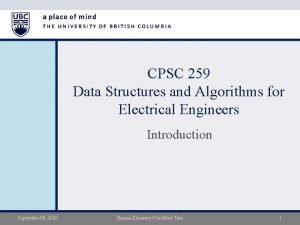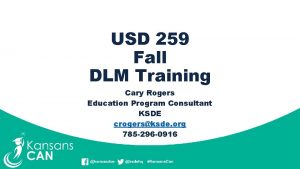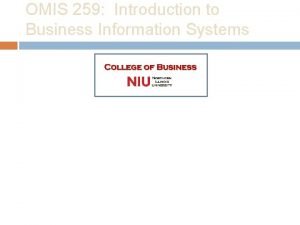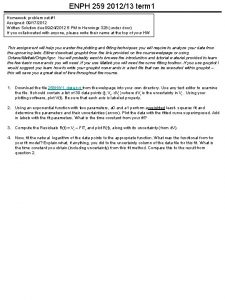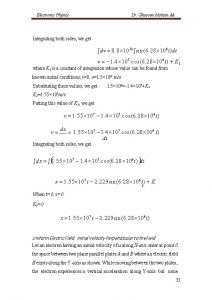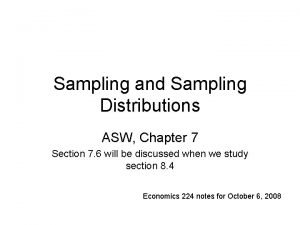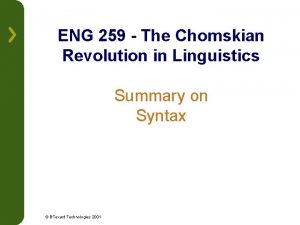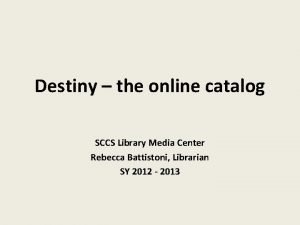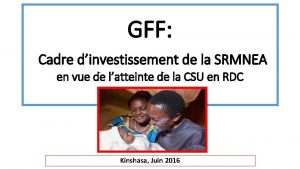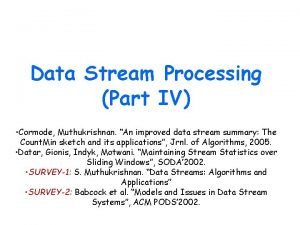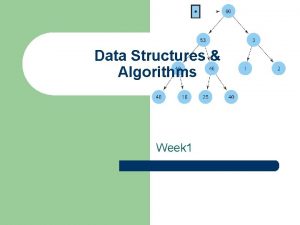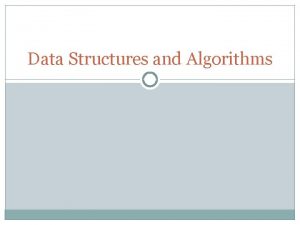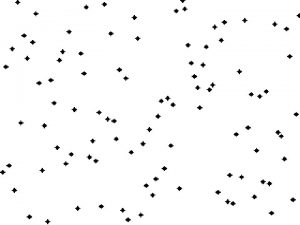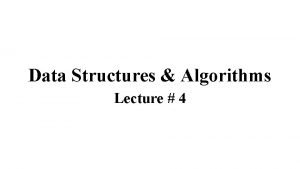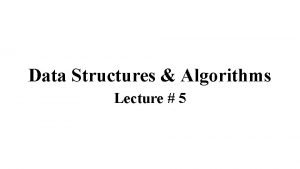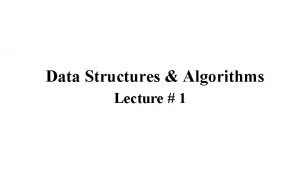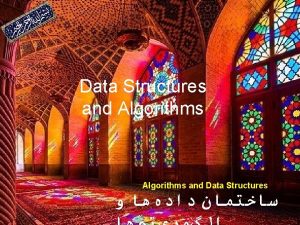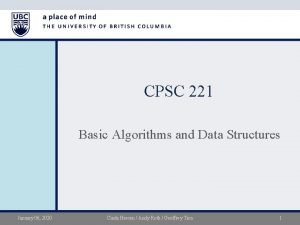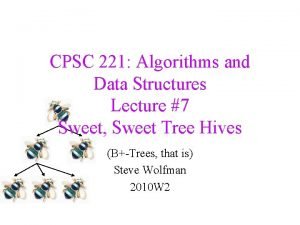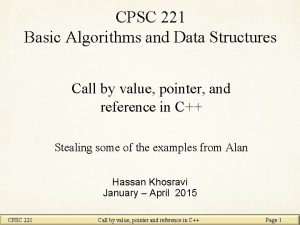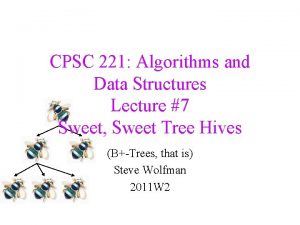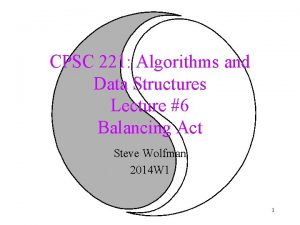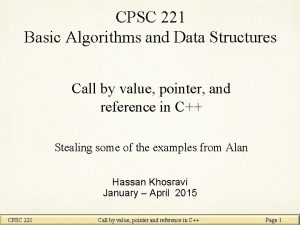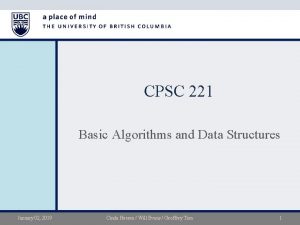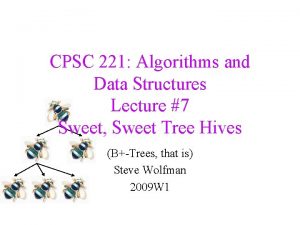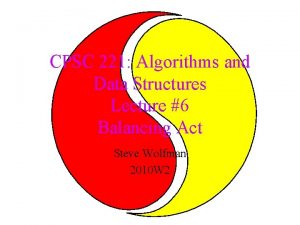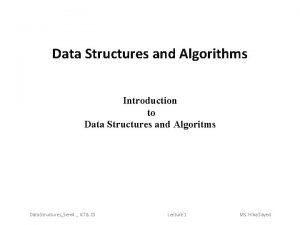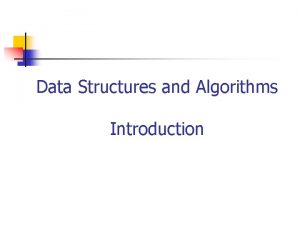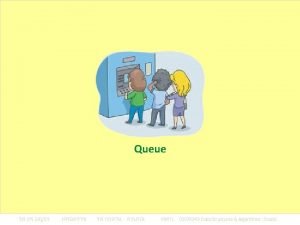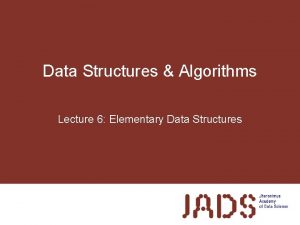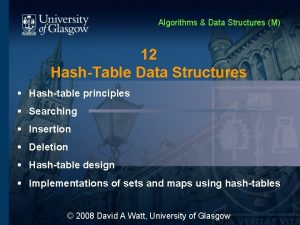CPSC 259 Data Structures and Algorithms for Electrical



























- Slides: 27

CPSC 259 Data Structures and Algorithms for Electrical Engineers Introduction September 09, 2020 Hassan Khosravi / Geoffrey Tien 1

Administration • Instructor: Geoffrey Tien, gctien@cs. ubc. ca Office: ICCS 245 (building inaccessible) Office hours (via Collaborate Ultra): Tuesday 09: 30 – 11: 00 Wednesday 09: 30 – 11: 00 • Course website: – http: //www. students. cs. ubc. ca/~cs-259/ – Lecture slides, labs, homeworks can be downloaded here – Administrative policies can be found here also • Other dynamic course content can be found on Piazza September 09, 2020 Hassan Khosravi / Geoffrey Tien 2

Textbook • Thareja, Reema – Data Structures Using C, Second Edition – Very detailed code examples • But any data structures book using C will be fine • I will aim to make lecture materials a fairly complete resource September 09, 2020 Hassan Khosravi / Geoffrey Tien 3

Piazza Course bulletin • https: //piazza. com/ubc. ca/winterterm 12020/cpsc 259/home • The Piazza bulletin board is required reading. It will be used for important material that may not be mentioned in class • Problems with the CPSC 259 course contents (e. g. lecture, lab, textbook, assignments) can be posted to Piazza • Students are encouraged to ask questions, and to respond to other students' questions • Only send e-mail if you have a private issue that you cannot post to Piazza September 09, 2020 Hassan Khosravi / Geoffrey Tien 4

Lecture • Lecture slides can be downloaded from the course website – 08: 00 -09: 00 session hosted on Collaborate Ultra via Canvas – Sessions will be recorded and available in Collaborate Ultra recordings – Light use of i. Clicker (Cloud) (worth 2. 5% of grade) • Download i. Clicker Reef app, or sign up to use web app – For students in alternate time zones, a separate session for answering i. Clicker questions will be run starting at 17: 30 Vancouver time September 09, 2020 Hassan Khosravi / Geoffrey Tien 5

Midterms • Midterm 1 – Tuesday, October 13 – Evening – 18: 00 – 19: 30 (90 minutes) – Open-book, invigilated via Zoom • Midterm 2 – Tuesday, November 17 – Evening – 18: 00 – 19: 30 (90 minutes) – Open-book, invigilated via Zoom • You must notify me of extra-curricular conflicts two weeks ahead of each date (September 29 / November 03)! September 09, 2020 Hassan Khosravi / Geoffrey Tien 6

Labs • There are 5 labs (cycles of 2 weeks each), starting week of Sept. 14 • Labs hosted on Zoom • In-lab component: – During week 1's lab time – Completed in pairs, has deliverables that are due either during your week 1 lab time, or, for certain deliverables, no later than during week 2's lab time • In-lab programming quiz: – During week 2's lab time, the first hour will be a programming test, done individually – Timed and invigilated via Zoom September 09, 2020 Hassan Khosravi / Geoffrey Tien 7

Labs • There are 5 labs (cycles of 2 weeks each) • Take-home programming assignment: – During each 2 -week cycle (minus a day) starting with week 1's lab time, a take-home programming assignment to be completed with your in-lab partner – E. g. if your lab time is on Monday, then your "two weeks" end just before midnight on Sunday (>13 days from start of week 1) – The last 50 minutes of lab time during week 2 will allow you and your partner to work on the take-home assignment. TAs will be available in the lab to help. – Submission of code via either Grade. Scope or Prairie. Learn (pending setup – details will be given in Lab 1) September 09, 2020 Hassan Khosravi / Geoffrey Tien 8

Written homeworks • There will be 2 written homeworks to complete during the term – These can be done in pairs – Purpose is to give you exposure to non-programming problems like those that may appear on the exams September 09, 2020 Hassan Khosravi / Geoffrey Tien 9

Evaluation Tentative – we reserve the right to change these! • September 09, 2020 Hassan Khosravi / Geoffrey Tien 10

Prerequisites • APSC 160 • If you do not have the prerequisite, you will be dropped from the course. Check with a CS advisor if you have a problem • The instructor cannot change your lab section or add you to the course – Contact the department for enrollment issues September 09, 2020 Hassan Khosravi / Geoffrey Tien 11

Programming environment Microsoft Visual Studio • Visual Studio will be used in labs – You may use another IDE of your choice, but you should check that your submitted code compiles and runs under Visual Studio • Details for obtaining a free copy via Microsoft Imagine will be given in Lab 1. September 09, 2020 Hassan Khosravi / Geoffrey Tien 12

Grade. Scope • Written homeworks, and exams will be graded via Grade. Scope • Access Grade. Scope via Canvas (pending setup) September 09, 2020 Hassan Khosravi / Geoffrey Tien 13

Course Overview 1 – APSC 160 review • Briefly review some key programming concepts from APSC 160 (functions, modularity, arrays) September 09, 2020 Hassan Khosravi / Geoffrey Tien 14

Course Overview 2 – Pointers • An object variable residing in memory contains an object, but a pointer specifies where an object is located (address) • Pointers can refer to objects that are allocated on demand Memory 0 2763 … • Pointers can be used for shared access to objects • Pointers are used in many complex data structures 2763 a = 5 2764 … 18, 266 2763 … September 09, 2020 Hassan Khosravi / Geoffrey Tien 15

Course Overview 3 – Structs (Records) • We have used primitive data types – int, float, string… • What if our program requires more complex data types? – E. g. a car dealership needs to keep track of its vehicle inventory • • • Year Make Model VIN Colour List of options • We'll see how we can create our own data types September 09, 2020 Hassan Khosravi / Geoffrey Tien 16

Course Overview 4 – Complexity • Suppose I have three functions that all produce the same result (on some given input) – How can I compare these algorithms? (in a platform-independent manner? – Are there tradeoffs between the algorithms? – Based on a specific set of inputs, can I conclude that one algorithm is better than the other algorithms? September 09, 2020 Hassan Khosravi / Geoffrey Tien 17

Course Overview 5 – Linked lists • A linked list is a data structure for collecting a sequence of objects, such that addition and removal of elements in the middle of the sequence is efficient. – Selling (removing) a car from dealership inventory – Adding a new item into a sorted list • This is not the case with arrays, assuming we keep the data compacted • Linked lists are constructed using pointers September 09, 2020 Hassan Khosravi / Geoffrey Tien 18

Course Overview 5 – Linked lists • A data structure in which elements can be added to or deleted from anywhere • Nodes are allocated as needed for each element (i. e. no need for extra unused space like arrays) • Each node points to the location of the next node in the list, thus every node contains: – The data stored in the node, and – A pointer or link to the next node in the list 5 12 13 19 22 node September 09, 2020 Hassan Khosravi / Geoffrey Tien 19

Course Overview 6 – Recursion • September 09, 2020 Hassan Khosravi / Geoffrey Tien 20

Course Overview 7 – Binary search tree • In APSC 160, we learned how to use an array to store some items and then search for them 12 34 89 18 21 – 1 • Using a different data structure, we can potentially find items more efficiently September 09, 2020 Hassan Khosravi / Geoffrey Tien 21

Course Overview 7 – Binary search tree • A binary tree is a data structure built from nodes (like linked lists) – Each node contains a data element, "left" pointer, and "right" pointer • Advantages: (mostly) quick search, insert, and remove operations • Disadvantage: complicated removal algorithm 13 29 7 2 8 21 33 23 September 09, 2020 Hassan Khosravi / Geoffrey Tien 22

Course Overview 8 – Heaps and priority queues • Suppose I have the following tasks to do for next week: 6 – Respond to Piazza questions 6 – Update course website 8 – Release homework 2 – Eat lunch 9 – Make lecture slides 1 – Sleep 3 – Replace worn-out pants – 1 – Bathe • If the larger numbers represent greater urgency, what kind of data structure can we use to help us (efficiently) pick high priority tasks first? September 09, 2020 Hassan Khosravi / Geoffrey Tien 23

Course Overview 9 – Sorting • If I have a collection of values (in an array), how can I put them in order? – Is there one algorithm that works well for all the different arrays and permutations I can supply? – Study some well-known sorting algorithms – Analyze the complexity of these sorting algorithm and look at tradeoffs September 09, 2020 Hassan Khosravi / Geoffrey Tien 24

Course Overview 10 – Hashing • In APSC we learned how to use an array to store some items and then search for them • Hashing still uses arrays, but uses a hash function to map keys (values) to integers – The converted integer is used to quickly find the right spot in the array for a given entry Alan Steve Hassan Will Ed September 09, 2020 Hassan Khosravi / Geoffrey Tien 25

Course Overview 11 – Graph theory (time permitting) • Graph is a structure for representing network relations • Many real-world problems can be shown by graphs Jasper Edmonton Kamloops Merritt Vancouver Kelowna Banff Calgary • What data structure is suitable for representing a graph (in a computer's memory)? • What is the shortest path between two cities on a road/flight map? September 09, 2020 Hassan Khosravi / Geoffrey Tien 26

That's all (for today)! • Next class we start with APSC 160 review • Homework: – Please ensure that your undergrad CS ID is activated! – https: //www. cs. ubc. ca/getacct/ September 09, 2020 Hassan Khosravi / Geoffrey Tien 27
 Cpsc 259
Cpsc 259 Professor ajit diwan
Professor ajit diwan Cos 423 princeton
Cos 423 princeton Data structures and algorithms tutorial
Data structures and algorithms tutorial Information retrieval data structures and algorithms
Information retrieval data structures and algorithms Data structures and algorithms bits pilani
Data structures and algorithms bits pilani Ajit diwan iit bombay
Ajit diwan iit bombay Data structures and algorithms
Data structures and algorithms Data structures and algorithms
Data structures and algorithms Ian munro waterloo
Ian munro waterloo Information retrieval data structures and algorithms
Information retrieval data structures and algorithms Data structures and algorithms
Data structures and algorithms Algorithms + data structures = programs
Algorithms + data structures = programs Usd259 portal
Usd259 portal Niuresponse
Niuresponse Homework 259
Homework 259 Physics 259
Physics 259 Asw-292
Asw-292 Descriptive and prescriptive grammar examples
Descriptive and prescriptive grammar examples Sccs library
Sccs library Srmnea
Srmnea Homology
Homology Data stream
Data stream Single pass macro processor
Single pass macro processor Assembler algorithm and data structures
Assembler algorithm and data structures Data structures and abstractions with java
Data structures and abstractions with java Adts, data structures, and problem solving with c++
Adts, data structures, and problem solving with c++ Data structures and algorithm
Data structures and algorithm
